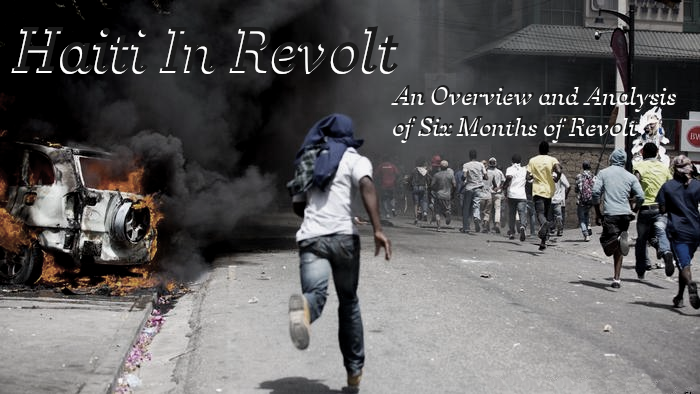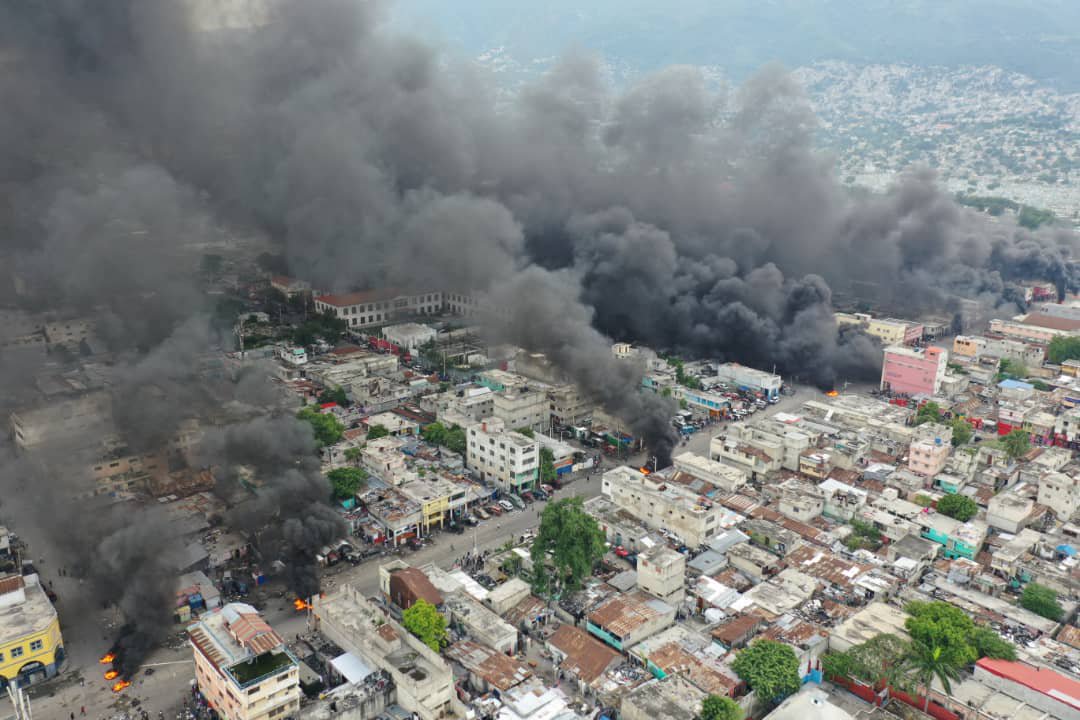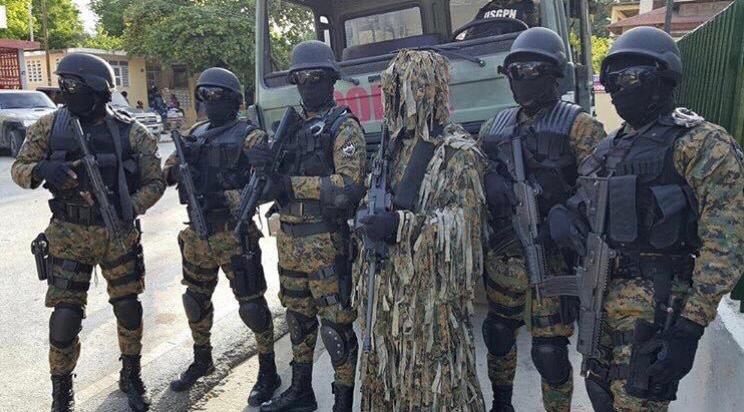
As we write the French Republic is burning and the North American anarchist movement has its eyes fixed on the fires, yet in our own backyard the former French colony of Haiti has been ablaze for months. Since the slave insurrections and struggle for decolonization (a struggle unfinished, we might add) the Haitian people have been in a near constant state of revolt against slavery and colonialism, dictatorships, neocolonialsm, occupation, and a crumbling state. The most recent incarnation of this social revolt started in July against corruption and has spread into a nation wide insurrectionary situation calling for the removal of the U.S backed ruling Haitian Tèt Kale Party (PHTK) and its leader, President Jovenel Moise. The state has responded with beatings, torture, shootings, massacres, and what many fear to be the return of dictatorship era deathsquads. Rather than crushing revolt, it has only intensified.
This recent anti-government wave of revolt comes from the revolt against corruption and a gas price hike from early July, though we can see its precursor in the resistance to the 2015/2016 elections and the post election wave of strikes and riots. The Haitian elections were marred by fraud and voter suppression, as well as the general rejection by the Haitian people who have long since lost faith in electoralism giving way to the lowest voter turn out in the western hemisphere. The first round of elections were held on October 25, 2015 and of the nearly 6 million registered to vote there was a turnout of only 28.8% and Jovenel Moise, a protégé of former President Michel Martelly and owner of a banana exporting operation, of the right-wing PHTK took the election with 32.81% of the vote, a mere 500,000 people compared to the size of the Haitian electorate (or compared to Haiti’s almost 11 million total population in 2015). Coming in second was Jude Célestin of Alternative League for Haitian Progress and Emancipation (LAPEH) with 25.27% of the vote. Since there was no one who held a clear majority a runoff election, initially scheduled for December 27th, 2015, was to decide the President
The election results were rejected by both the Haitian people as well as opposition parties which kicked off protests decrying the fraud and corruption and demanding an annulment. Protests spread across the country and quickly escalated with election offices burned, streets blockaded with burning barricades, and clashes with Haitian National Police and UN “Peacekeepers”.
On December 22nd the Provisional Electoral Council (CEP) indefinitely postponed the runoff election due to the popular rejection of the initial election results. On January 1st then President Martelly declared the runoff elections would be held on the 17th, he later would change the runoff date to the 24th which would then be canceled due to intense riots and blockades as a part of the call for a week of rebellion against the scheduled elections.

The back drop to all of this was the United States urging the elections to take place as quickly as possible, urging the state to ignore the Haitian people and have the January 24th runoff election. A verification commission was set up to audit the results of the August 2015 election, a move the United States was displeased with as U.S. State Department Haiti Special Coordinator Kenneth Merten states, “We hope it is very, very quick and does not change the results of the election.” The Secritary of State John Kerry even chimed in saying, “The Haitian players, the so-called leaders, need to understand there’s a clear limit to the patience, the willingness of the international community to condone this process of delay.”
However, against the wishes of much of the so-called “international community”, a lovely name for the United States and the U.N., on May 30th the verification commission recommended throwing out the results of the August 2015 election. The new election was to be held in early October but was delayed as the country, which was still trying to recover from the 2010 earthquake, was hit by Hurricane Matthew. The new election was finally held on November 20th with people from the social democratic Fanmi Lavalas party and the PHTK filling the streets after polling stations closed, claiming they have won.

Members of the General Security Unit of the National Palace (USGPN) try to disperse supporters of Fanmi Lavalas political party as they march next to the National Palace of Port-au-Prince, Haiti, November 21, 2016. REUTERS/Andres Martinez Casares
Between the devastation of the hurricane and the Haitian peoples exhaustion from the year long election process, voter turnout for this election was even lower than last time at just 18%. Of that 18% that voted, Jovenel Moise took 55% of the vote and with an ‘absolute majority’ won the election as a whole. Unwilling to accept more years of PHTK rule, again the Haitian people overwhelmingly rejected the results and protests and conflicts broke out, with reports of demonstrations, burning barricades, and gunshots, especially in the La Saline slum which is a major stronghold of social democratic Fanmi Lavalas which called the election an “electoral coup”.
On Febuary 7th, 2017, Jovenel Moise was sworn in as Haiti’s 58th President. Already in the peoples bad graces and coming into office with suspicions of money laundering, he declared, “we will invest in and cultivate available lands, build roads, bridges, and electricity networks… build schools, dispensaries, and hospitals, facilitate great tourist projects, take all the advantage we can from the HELP and HOPE acts [of the U.S. Congress] by promoting investment in the assembly sector.“, promises that have gone unheeded.
His first year in office was marked blatant corruption as well as by continuous protests, strikes, riots, and blockades for minimum wage increases and against the government that have taken an increasing revolutionary stance with protesters chanting “Down with the government, down with the bourgeoisie!” The Haitian State has responded with a wide range of repression through strike breaking and firing on with live ammo. This cycle of revolt and repression has been ongoing and it’s a pattern that will repeat itself with greater intensity in the next year.
An intensely unpopular right wing government riddled with abuse and corruption and wave after wave of protest and revolt in the winter set the stage for a hot summer. In July, using the cover of the World Cup hoping everyone would be too distracted to notice, the government implemented an IMF imposed reform raising the price of gasoline, diesel, and kerosene by 38%-51%, with a liter of diesel costing around 4$ USD and a liter of gasoline costing about 5$ USD. This price hike also meant that costs for public transportation would rise and for a country who’s minimum wage is between 215 Gourdes (about 3 USD) to 500 Gourdes (about 7 USD) a day depending on industry any price raise is a large chunk out of a days wages.
This all out assault on the poor (that the IMF claimed is actually helping the poor) didn’t go unnoticed and the state’s hope for people being distracted by the World Cup fell apart when Haitians took to the street as it ended. Protests, mostly centered in Haiti’s capital Port-au-Prince, quickly escalated to rioting and looting and not even 24 hours later the state reversed the price hike, but that didn’t get people off the streets and days of intense revolt followed in which multiple people were killed and ended up with the resignation of Prime Minister Jack Guy Lafontant and members of his cabinet.
Resumen Latinoamericano describes the revolt saying,
“Hundreds of thousands of protesters are in the streets, building barricades, setting fire to service stations, car dealerships, premises, homes and so on and there are calls to occupy the centre of the capital, where the palace of government is located.”
They follow up with,
“It is important to note that for the moment, no political force is commanding the actions, but rather that they are developing in an uncoordinated way. The organizations are trying to articulate to give this uprising a clearer political direction and avoid the situation ending in generalized uncontrolled violence.”
This bears mentioning because much of the revolts that have happened, like the resistance to the elections, are called for by opposition parties and while they always have the possibility of getting totally out of control and can to a degree go beyond the parties threshold for acceptable conflict they are still able to be reigned back in. This, of course, isn’t to say that the Haitian people are being led around by the opposition parties but that the opposition parties are apt in using and diverting the long burning rage of the Haitian people from asserting their power to directly meet their needs into being tools to get more leverage in the state, as any political body vying for state power aims to do.
The fires were still smoldering when in August an anti-corruption social movement under the banner of the #PetroCaribeChallenge began to emerge. What started as just an airing of grievances around government corruption based on a Senate committee report from last year quickly kicked off another wave of protest and intense revolt. The report details the misuse and disappearance of at least 1.7 billion USD from the PetroCaribe Fund, a fund established through the Venezuelan “economic solidarity” program PetroCaribe which for Haiti was filled by the 40% of revenues from cheap Venezuelan oil. A program that the United States was not a fan of.
The PetroCaribe fund was supposed to be used for social and economic projects as well as reconstruction from the 2010 earthquake. The outrage of this scandal was built upon not just the past months of revolt but years of corruption. Toward the end of August protestors began to hit the street and trying to save face and assert the legitimacy of the state both current and former Presidents pack an investigation into the misuse of the funds. Yet protests continued and would continue to escalate into October, which would prove to be a bloody month.
A protest was called for Dessalines Day, a day commemorating the death of ex-slave and revolutionary leader in the Haitian Revolution Jean-Jacques Dessalines. The lead up to the protest was filled with intimidation by the state and the Haitian ruling class, with a police memo fearing attacks on that day and some opposition party lawyers get questioned by a state prosecutor about the protests. Tensions begin to rise higher as highschool students begin to join the protests and videos of wealthy Haitians begin to circulate shooting weapons as a threat against the upcoming protest and in the days leading up banks and businesses begin to take steps to prepare.
The day before there were burning barricades erected and in the night there were ceremonies to invoke the ancestors. As the day began a government event is disrupted and police have to fire into the air to disperse the crowd. All over the country there are protests and clashes. In the end multiple buildings and vehicles were destroyed, 11 cops were injured, many police vehicles torched, and at least 2 people were killed. Days later video spreads of police beating people who were suspected of taking part in the protest and the bodies of 3 protestors who were arrested are found on the outskirts of Port-au-Prince.

Nightly protests begin to take to the street and at the end of the month a funeral for those killed by police at the Dessalines Day demo is held. Police attack and open fire on the funeral which kicks off intense rioting in the capital city. Rebels put up flaming barricades all over the city and clash with the police.

In November more protests erupt calling for the removal of the president, and at this point police responding with live ammo is the norm as the state militarizes more to intimidate rebels. On the 13th a massacre takes place in the La Saline slum, a Lavalas stronghold, and while the state is saying that it was a gang turf war the account of survivors tells a different story,
What was reported by residents — with shared photos on social media — the assassins appeared in BOID (Brigade d’opération et d’intervention départementale) uniforms and new vehicles. In addition, some of the known members of the Base Nan Chabon gang led by Serge Alectis — widely known as Ti Junior — were In the same mercenary soup wearing the uniforms. What is now becoming even more shared amongst Haitians is that the new amorphous mercenary group is fronted by former MINUSTAH (UN) officer Mohammad Nusari from Yemen. It is this “Security Consultant” that also brings with him the perceived involvement of the US Embassy, the CIA and the UN.

A 3 day general strike is called shutting down most of Haiti as barricades go up. People hit the streets en-mass after the strike and police respond with teargas and gunfire. Protests continue, in one town police kill Beaumont resident Camecio Simon and people respond by burning down the police station. The 28th anniversary of the election of Haiti’s first freely elected president, Jean-Bertrand Aristide, is marked by protests.
As the situation currently stands demonstrations calling for the removal of President Moise are still happening and the newly elected Prime Minister Jean-Henry Céant has tried to appeal to “patriotism” to call a “truce” for Christmas, but it doesn’t look like there are any signs of slowing down.
For us as insurrectionary anarchists in North America the inevitable revolts to come as the crumbling Haitian state tries to save itself offers us a chance to on one hand chip away at our movements eurocentrism and on the other elaborate a practice of internationalism.
We do not find it surprising that the places and movements we tend to give our attention, material solidarity, and rage to are generally european, almost never anywhere with a black majority. We understand that, as A. G. Schwarz words it in the text The Spirit of December Spread ‘Round the World, “…solidarity is based on affective bonds.” Following this, it makes sense that an overwhelmingly white anarchist movement would find its inspiration and give most of its attention to explicitly anarchist forces (which is good) or other movements that look more like them. To illustrate the point further we pull this quote from the same text,
“And we may even be overestimating the limits of our own solidarity. When immigrants in Omonia rioted in June 2009 after a cop ripped up a Koran in a racist police raid, shockingly few anarchists took part. The tearing of a Koran was interpreted by many immigrants as an attack on their identity, their difference, and thus their very survival. Greek anarchists seemed to interpret it as a religious squabble, much the same way that Italian high school students might fail to understand what the killing of a Greek kid had to do with them.”
However, if our anarchism is to be internationalist, if we want to generalize insurrection across borders and across identities, we must actively be looking for and taking part in revolt outside of the usual places and identifying ourselves not just with anarchists but with anarchistic and ungovernable forces, of course with a critical eye to the content of their politics lest we relive the anarchist fascination with the 2014 Ukraine revolts that has anarchists unknowingly cheer-leading for neo-nazis because they fought police.
When we talk of elaborating a practice of internationalism, and particularly in the context of Haiti, we are talking about everything from intervening in workers struggles and forming state-side support campaigns to counter-information campaigns about and attacks against the means and logistics through which the United States intervenes in Haiti – through the State Department, the CIA, USAID, the U.S. Military, and through the United Nations.
This can also take the form of putting in the effort to learn Kreyol, like many anarchists took the time and effort to learn Kurdish to support struggles in Rojava, to translate texts and analysis to and from to boost the voices of autonomous Haitian rebels and facilitate conversations between movements. We can also look to supporting groups like the autonomous workers organization Batay Ouvriye or the Haiti Info Project, one of the few on the ground grassroots groups putting out new and analysis of revolt in Haiti.
The continuous and increasingly escalating waves of revolt are looking like they might force out the President by early next year, however with the reformation of the Haitian Military and a violent history of US and UN intervention , not to mention the compounding effects of mass deforestation and climate change, the future looks as grim as it does promising.
As has been noted in many other instances the left path of electorialism runs up against the dictatorship of capital and the need of the state to first and foremost secure the existence of the state even at the expense of those it governs. In Haiti, with the direct and constant meddling of the US and UN, the military, and bourgeois leftovers of the Duvallier era, left electorialism is only a set up for worse to come. If there is hope for real peace and stability for the Haitian people it will come through abandoning political parties and state machinery in favor of building the autonomous power to take care of and defend each other. We can see the seeds of this in the autonomous revolts initiated by the Haitian people rather than called for by opposition parties and in groups like the autonomous workers organization Batay Ouvriye.
All struggles for liberation are connected, those directly happening in the backyard of the United States directly effect our struggles, and ours theirs. We will be continually keeping an eye on unfolding social conflict looking for ways to support struggle stateside, and we hope others do as well.
